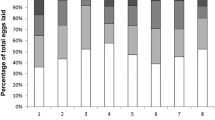Summary
Colony composition and behavior of queens in the ponerine antOdontomachus rixosus were investigated in Bogor (West Java) and Ulu Gombak (Penisular Malaysia). The colonies had multiple dealate queens, with a maximum of 82 queens per colony. Majority of queens (92.4%) were inseminated and laid eggs, however, the degree of ovarian development slightly varied among individual queens. Queen behavior was observed for one colony in laboratory. Reproductive condition of individual queens was related with behavioral profiles. Virgin queens and mated queens having less developed ovaries engaged in foraging, larval care and grooming workers while fertile mated queens performed egg care and grooming queens. Aggressive interactions among coexisting queens were not observed.
Similar content being viewed by others
References
Brandao, C. R., 1983. Sequential ethograms along colony development ofOdontomachus affinis Guerin (Hymenoptera: Formicidae, Ponerinae).Ins. Soc. 30:193–203.
Brown, W. L., 1976. Contribution towards a reclassification of the Formicidae. part VI. Ponerinae, Tribe Ponerini, Subtribe Odontomachiti. Section A. Introduction, Subtribal characters. GenusOdontomachus.Studio Entomologica 19:67–171.
Buschinger, A., 1968. Mono- und Polygynie bei Arten der GattungLeptothorax Mayr (Hymenoptera, Formicidae).Ins. Soc. 15:217–226.
Colombel, R., 1970. Recherches sur l'éthologie et la biologie d'Odontomachus haematodes L. (Hymenoptera: Formicidae, Ponerinae). Etude des populations dans leur milieu naturel.Ins. Soc. 17:183–198.
Colombel, P., 1972. Recherches sur l'éthologie et la biologie d'Odontomachus haematodes L. (Hymenoptera: Formicidae, Ponerinae). Biologie des ouvrières.Ins. Soc. 19:171–194.
Heinze, J. and T. A. Smith, 1990. Dominance and fertility in a functionally monogynous ant.Behav. Ecol. Sociobiol. 27:1–10.
Hamilton, W. D., 1972. Altruism and related phenomena, mainly in social insects.Ann. Rev. Ecol. Syst. 3:193–232.
Haskins, C. P. and E. F. Haskins, 1951. Notes on methods of colony foundation of the ponerine antAmblyopone australis Erichson.Am. Midland Nat. 45:432–455.
Hölldobler, B. and E. O. Wilson, 1977. The number of queens: an important trait in ant evolution.Naturwissenschaften 64:8–15.
Hölldobler, B. and E. O. Wilson, 1990.The Ants. Belknap Press of Harvard Univ., Cambridge, MA. Ito, F., 1990. Functional monogyny ofLeptothorax acervorum in northern Japan.Psyche 97:203–211.
Ito, F., 1993a. Functional monogyny and dominance hierarchy in the queenless ponerine antPachycondyla sp. in West Java, Indonesia.Ethology 98:126–140.
Ito, F., 1993b. Social organization in a primitive ponerine ant: queenless reproduction, dominance hierarchy and functional polygyny inAmblyopone sp. (reclinata group) (Hymenoptera: Formicidae: Ponerinae).J. Nat. Hist. 27:1315–1324.
Ito, F. and S. Higashi, 1991. A linear dominance hierarchy regulating reproduction and polyethism of the queenless antPachycondyla sublaevis.Naturwissenschaften 78:80–82.
Ito, F. and K. Ohkawara, 1994. Spermatheca size differentiation between queens and workers in primitive ants: relationship with social structure of colonies.Naturwissenschaften 81:138–143.
Keller, L., 1988. Evolutionary implications of polygyny in the Argentine ant,iridomyrmex humilis Mayr (Hymenoptera: Formicidae): an experimental study.Anim. Behav. 36:159–165.
Keller, L., Passera, L. and J. P. Suzzoni, 1989. Queen excitation in the Argentine ant,Iridomyrmex humilis.Physiol. Entomol. 14:157–163.
Ledoux, A., 1952. Recherches preliminaires sur quelques points de la biologie d'Odontomachus assiniensis Latr. (Hym. Formicidae).Ann. Sci. Nat., Zool. 11:231–248.
Medeiros, F. N. S., L. S. Lopes, P. R. S. Moutinho, P. S. Oliveira and B. Hölldobler, 1992. Functional polygyny, agonistic interactions and reproductive dominance in the neotropical antOdontomachus chelifer (Hymenoptera, Formicidae, Ponerine),Ethology 91:134–146.
Oliveira, P. S. and B. Hölldobler, 1990. Dominance orders in the ponerine antPachycondyla apicalis (Hymenoptera, Formicidae).Behav. Ecol. Sociobiol. 27:385–393.
Oliveira, P. S. and B. Hölldobler, 1991. Agonistic interactions and reproductive dominance inPachycondyla obsuricornis (Hymenoptera: Formicidae).Psyche 98:215–226.
Peeters, C., 1987. The diversity of reproductive systems in ponerine ants. In:Chemistry and Biology of Social Insects (Eder, J. and H. Rembold, eds.) pp. 253–254. Verlag J. Peperny, München.
Peeters, C., 1993. Monogyny and polygyny in ponerine ants with and without queens. In:Queen number and Sociality in Insects (Keller, L. ed.) Oxford Univ. Press, pp. 234–261.
Peeters, C. and R. Crewe, 1985. Worker reproduction in the ponerine antOphthalmopone berthoudi — an alternative form of eusocial organization.Behav. Ecol. Sociobiol. 18:29–37.
Rosengren, R. and P. Pamilo, 1983. The evolution of polygyny and polydomy in mound buildingFormcia ants.Acta. Ent. Fenn. 42:65–77.
Ross, K. G., 1988. Differential reproduction in multiple-queen colonies of the fire antSolenopsis invicta (Hymenoptera: Formicidae).Behav. Ecol. Sociobiol. 23:341–355.
Stille, M., Stille, B. and P. Douwes, 1991. Polygyny, relatedness and nest founding in the polygynous myrmicine antLeptothorax acervorum (Hymenoptera: Formicidae).Behav. Ecol. Sociobiol. 28:91–96.
Villet, M. H., R. M. Crewe and F. D. Duncan, 1991. Evolutionary Irends in the reproductive biology of ponerine ants (Hymenoptera: Formicidae).J. Nat. Hist. 25:1603–1610.
Author information
Authors and Affiliations
Rights and permissions
About this article
Cite this article
Ito, F., Yusoff, N.R. & Idris, A.H. Colony composition and queen behavior in polygynous colonies of the oriental ponerine antOdontomachus rixosus (Hymenoptera Formicidae). Ins. Soc 43, 77–86 (1996). https://doi.org/10.1007/BF01253958
Received:
Revised:
Accepted:
Issue Date:
DOI: https://doi.org/10.1007/BF01253958




